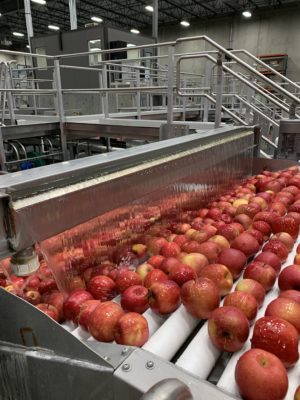Informing on the FSMA water quality rule
While we’re waiting for the dust to settle around newly proposed changes to the Food Safety Modernization Act (FSMA) agricultural water requirements, let’s take a look at what we’ve learned about ag water safety in recent years — and the role that research-informed knowledge has played in driving regulatory change.
No surprise, the fresh produce supply chain has a necessary relationship with water. We rely on water to grow, cool, pack, process, and retail or serve our bounty. Yet we also know that water can efficiently introduce or transfer pathogens to our products at points all across that value chain.

So, answering industry’s questions about water safety — specifically, measuring and managing microbial water quality — has been the top priority at Center for Produce Safety (CPS) since it was founded in 2007, which it has done by focusing on produce-specific food safety research. To date, CPS has invested $9 million in industry and public funds to fund 41 ag-water research projects. Specific to wash water, the center has invested another $2.9 million to fund 17 additional projects.
CPS then transfers learnings to industry and other interested stakeholders via its annual Research Symposium (taking place virtually in 2020 and 2021), webinars, articles in trade press outlets and other channels. Additionally, CPS funded scientists publish their findings in respected peer-reviewed journals, largely in open-access sources.
Here’s a sampling of what we’ve learned from CPS’s water research.
- We should assume our ag water sources can be contaminated. CPS-funded surveys of water sources revealed that human pathogens and/or their indicators can be found in open irrigation water sources from Georgia to Washington state during growing seasons. (Visit CenterforProduceSafety.org to review related research reports, such as Vellidis 2014-2015.)
- Don’t just sample the water: Pathogens can harbor and persist in the sediments of open water sources such as ponds and canals. Storms, water system maintenance and other factors can disturb those sediments, releasing pathogens into water which can then transfer to crops. Equally, water-intake equipment allowed to rest near or on these sediments can transfer contaminated particulates to the distribution system. (See, for example, Gerba 2018.)
- Be careful what you use as an indicator. The presence of generic E. coli in a water source is not a good indicator of the presence of human pathogens. (See, for example, Rock 2012.)
- Wash water doesn’t sterilize produce. Instead, disinfectants control microbial populations that can build up in wash water over time, thereby preventing product from being cross-contaminated. (See, for example, Sánchez Moragas 2019.)
- Look beyond sanitizers. When used properly and monitored aggressively, common sanitizers including peroxyacetic acid and sodium hypochlorite can reduce — but do not eliminate — microorganisms in irrigation water. “It is recommended that agricultural water treatment should be viewed as a risk reduction practice rather than a risk elimination practice and should be part of an overall layer approach to food safety,” said Channah Rock, Ph.D., University of Arizona. (See, for example, Rock 2021.)
CPS-funded research reported in 2020 shed much-needed light on another component of FSMA water quality regulations. FSMA allows growers to use water exceeding safety levels on a crop, if they wait a prescribed time before harvesting that crop. However, existing science didn’t agree on pathogen die-off rates. Cornell University’s Renata Ivanek, Ph.D., led an international team that set out to bring more surety to the subject. To test the relationship between weather conditions and pathogen die-off, she and her colleagues replicated the same field experiment in the same location multiple times, in locations here and abroad — collecting more than 5,000 produce samples in all. The team was able to develop a model to predict pathogen die-off as a function of bacteria type, produce type, dewpoint and relative humidity. The model appears to predict die-off rates substantially better than FSMA’s matrix, suggesting the rule should be updated.
The rest of the story
The original FSMA water-testing requirements were so complex and prescriptive that industry leaders asked CPS to host a summit of scientists, industry and regulators to review current science and consider options. After that colloquium in early 2017, the Food and Drug Administration announced it was reconsidering its approach to ag water safety and postponed compliance with the 2015 regulations. Four years later, the agency has now proposed replacement rules.
Center for Produce Safety research doesn’t just teach our supply chain how to better safeguard fresh produce, to protect consumers and our businesses alike. It also helps us to advocate for science-based legislation and regulation. To learn how you can benefit from and support CPS’s work, visit www.CenterforProduceSafety.org.
 — Dave Murray is a partner with GoodFarms, which grows and markets indoor and outdoor, conventional and organic berries and tomatoes from California, Baja and mainland Mexico. He is a member of Center for Produce Safety’s volunteer Board of Directors, which keeps CPS focused on its mission: to fund science, find solutions and fuel change in fresh produce food safety.
— Dave Murray is a partner with GoodFarms, which grows and markets indoor and outdoor, conventional and organic berries and tomatoes from California, Baja and mainland Mexico. He is a member of Center for Produce Safety’s volunteer Board of Directors, which keeps CPS focused on its mission: to fund science, find solutions and fuel change in fresh produce food safety.
Top photo: A surface water source. (Trevor Suslow, Ph.D.)










